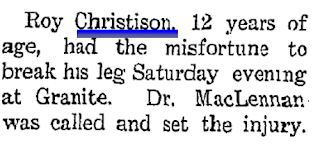Former Flying W Wrangler Joe Stephenson added the perfect fiddle part to the song for my fiddle-playing outlaw. And Ernie Martinez, nominated for the 2013 Instrumentalist of the Year by the Western Music Association, played the dobro, intoning a lonesome train whistle on the break.
"Freedom in January" tells the story of Ernest Christison who, along with ten other prisoners, knocked out a hole in the brick wall and "broke jail." The jail is now the school administration offices. At the back of the building, you can still see where the bricks were replaced.
 |
| The Buena Vista Democrat (http://ColoradoHistoricNewspapers.org) |
Ernest Christison and Albert Sweeny ran half a mile to the Arkansas River. This photo was taken 126 years later on the anniversary of the jail break. Fortunately for the men, there wasn't snow on the ground so they couldn't be tracked. They crossed the river and hid on the hill a while, and then started walking south to Salida. They crossed the river again near Nathrop. Thinking of the men walking through the freezing cold water prompted the line, "Freedom in January is worth the frost."
Ernest and Albert made it to Thomas Cameron's home just north of Salida, where they found food, a Winchester, and a place to sleep. But Cameron's was being watched and the men were rudely awakened by "a shotgun barreled side by side" shoved in their faces. After they were captured, the men returned to Buena Vista on the train with an armed guard.
Lonesome County Road is available for order at http://BarryWardMusic.com/new-cd/ Be sure to check out Barry's schedule and see him in concert when he is in your area.























